The Worst Chemicals in Cleaning Supplies
These potentially toxic chemicals commonly found in cleaning products, laundry detergents, air fresheners, and more can negatively affect not only our personal health and the health of our families, but they also affect the health of our ever-injured environment (fish don’t like or deserve poisons any more than we do).
This list below is very abbreviated, but it’s a good place to start when you begin making safer choices at home.
This list below is very abbreviated, but it’s a good place to start when you begin making safer choices at home.
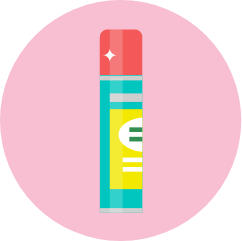
SYNTHETIC FRAGRANCES
The word “fragrance” on ANY label is typically a mixture of several dozen to several hundred chemicals, most of which have not been evaluated for their safety. This is a loophole in the governing systems that allows companies to claim that their fragrance “recipe” is a trade secret. This is appalling and unacceptable on all levels.
The words fragrance, perfume or parfum on ANY label should be avoided at all costs. Look for EO or essential oils instead. And yes, this means most perfumes, candles, plug-ins, air fresheners, detergents, cleaning products and personal care products like skincare and makeup. Smelling like synthetic berries is not as sweet as it sounds.
Potential Health Effects:
Potential Health Effects:
- Allergic reactions
- Asthma
- Endocrine disruption
- Neurotoxicity
- Cancer
- Respiratory / lung issues
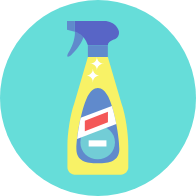
STABILIZERS
Included to help stabilize a formula for longer shelf life. Examples include ethylene oxide or polyalkylene oxide.
Potential Health Effects:
- Eye irritation
- Skin reactions like rash and dermatitis
- Lung irritation

BLEACH
Either separately or included in a detergent formula, when chlorine bleach combines with waste water, toxic organic compounds are formed. Bleach is unsafe for us to touch, breathe in and spread onto surfaces or clothing. What goes ON our body ends up IN our body. Toss the Clorox wipes today. It’s time.
Potential Health Effects:
- Skin reactions like rash and dermatitis
- Eye irritation
- Lung and respiratory problems
- Kidney and liver damage
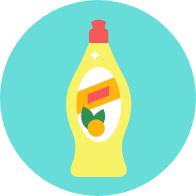
PHOSPHATES AND EDTA
Included in formulas to soften hard water, remove grease and dirt, and suspend dirt so that it doesn’t settle back on clothes or dishes during the wash cycle.
Potential Health Effects:
- Skin rash
- Dizziness
- Throat, breathing and lung issues
Environmental Impact:
- Many US states have banned phosphates in dishwasher detergents because the chemical compounds also pollute lakes, bays and streams.
- These compounds create algae blooms and starve fish of oxygen.
- Widespread damage to ecosystems are found to be toxic in animal studies.
- And yes, any residue left on clothes or dishes can have the same effects on us. Real nice.
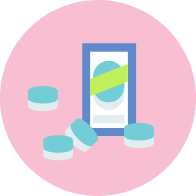
OPTICAL WHITENERS
Chemicals that remain on the surface of fabric to absorb UV light and help clothing appear brighter, whiter, and more vibrant. This is an optical illusion. They are synthetic chemicals added to laundry detergent. On the label you may see: optical brightening agent, fluorescent brighteners, fluorescent white dye.
Potential Health Effects:
- Contact dermatitis
- Possible genetic mutations in aquatic life. Not good.
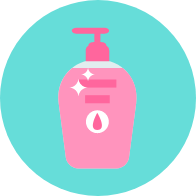
1,4 DIOXANE
This is a trace contaminant of some chemicals used in cosmetics, detergents and shampoos. The most common example is as a by-product of sodium lauryl sulfate. There is some controversy around SLS, but we recommend avoiding it completely. The EPA has established that 1,4 dioxane is likely to be carcinogenic to humans. So the big question is: Why would we slather it on our skin and wash our clothes and dishes with it? Um, no thanks. BIGGER question: Why is this even legal?
Potential Health Effects:
- Cancer
- Respiratory issues
- Allergies
- Hormone disruption
- Kidney disease
- Nervous system disorders
- Brain toxicity
- Liver disease
- Immune system impairment
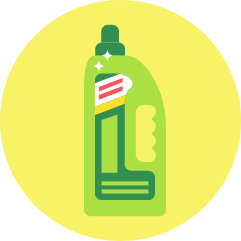
SURFACTANTS
These are compounds that interact with both water and soil to help them mix together so the soil will wash away with the water. Surfactants are petroleum based ingredients and largely unregulated and untested for safety in humans. So wait, these are chemicals that are often added to help a product “clean better” (this makes no sense to us at all). Here are a few chemicals that act as surfactants:
• Sodium lauryl sulfate (SLS)
• Diethanolamine (DEA)
• Quaternium-15 (formaldehyde)
• Linear alkyl benzene sulfonates (LA)
• Benzene
• Petroleum distillates
• Sodium lauryl sulfate (SLS)
• Diethanolamine (DEA)
• Quaternium-15 (formaldehyde)
• Linear alkyl benzene sulfonates (LA)
• Benzene
• Petroleum distillates
Potential Health Effects:
- Organ toxicity
- Developmental and reproductive problems
- Neurotoxicity
- Possible mutations
- Cancer
- Eye and skin irritation
- Lung damage
- Liver problems
Environmental Effects:
- Toxic to aquatic life
There will always be more to learn and share and we promise to bring you the most updated, helpful resources we can. Don't let the big fancy scientific words freak you out. Look them up, ask us, and if you're still not sure, avoid them like the plague. ALWAYS error on the side of safety. Our health is NEVER worth the risk. Cheers to seeking, listening, deciding and doing. We got this.
xo
Jayna + The SQUEAK Team

We’re working with the EWG!!
SQUEAK’s All PERP will be one of the first cleaning products to be recommended by the Environmental Working Group when this category launches in late 2019.
Do More With EWG
Also known as Environmental Working Group. This non-profit group specializes in research and advocacy in the areas of agricultural subsidies, toxic chemicals, drinking water pollutants, and corporate accountability.
EWG CONSUMER GUIDES
These quick guides written by the Environmental Working Group (EWG) are a great resource to help you make safer choices.
EWG HEALTHY LIVING
With this app, you can scan barcodes on foods, personal care, beauty and household products for a safety rating.
1 is the best and 10 is straight up poison. We like to recommend products that are 1’s with 2’s being an exception sometimes.
1 is the best and 10 is straight up poison. We like to recommend products that are 1’s with 2’s being an exception sometimes.
EWG HALL OF SHAME
Take a look at top common household cleaners that EWG listed as products that may present health risks to people who are unaware of their effects or children who ingest or spill them on themselves.
Safer Alternatives to Bleach
There are many safe and natural alternatives for removing stains and keeping whites white.

Hydrogen Peroxide
Add 1 cup to a load of whites as you would bleach. To further its whitening effects, soak clothes in a 1:8 mixture of hydrogen peroxide to water, and then wash as usual.
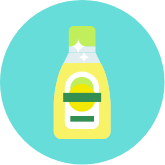
Vinegar
White vinegar is another natural cleaning substance that cleans and deodorizes. Add between 1/4 cup and 1/2 cup to your laundry, along with detergent, and wash as usual.
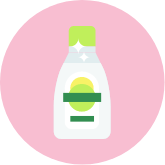
HP + Distilled White Vinegar
Mix these two ingredients at a 50/50 ratio. This mixture has actually been proven to kill mold BETTER than bleach in porous surfaces (think wood, fabric, etc). You can also use this in your home as you would bleach.
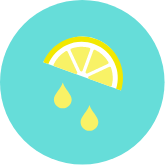
Lemon Juice
Add to your regular load of laundry in ½ cup to 1 cup depending on the load, or rub directly on a stain and hang outside. Let the sun do the rest of the work.
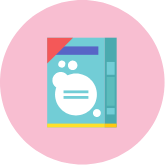
Washing Soda
This form of baking soda acts as a whitener and detergent booster and can be added your load of laundry with your detergent in quantities between ¼ cup and 1 cup, depending on the size of the load of laundry.
